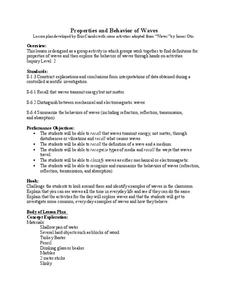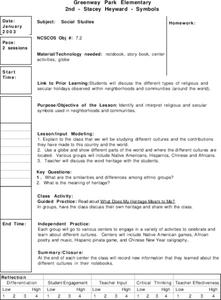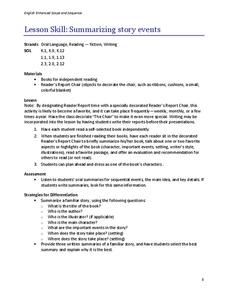Curated OER
Poetry To My Ears
Students investigate the 50 States Quarters Program. They use the state of Idaho as a basis for creating context for the lesson. The image on the coin becomes the subject. They differentiate between the reverse and obverse side of the...
Curated OER
Native American Folklore
Students create a paper that differentiates between written and oral history. They also create a visual narrative that is interpretative.
Curated OER
The Biography of Robert Boyle
Young scholars research and chronologically sort written information about Boyle's life. They create a time line of importand events in Boyle's life and write a biography on Robert Boyle.
Curated OER
Fire Safety Message
Students review what they have discovered from the lesson on House of Fire Hazards writing a list of fire hazards on the board and discussing. They also are reminded to tell an adult if they see a fire hazard and not to correct things...
Curated OER
Radio
Students explain in their own words how radios work. In this technology instructional activity, students discuss the importance of radio today. They differentiate AM and FM bands.
Curated OER
How Does Meiosis Lead To a Fetus?
Young scholars discuss the stages of meiosis. In this life science instructional activity, students create an illustration of each stages. They write a short story about a character that went through meiosis.
Curated OER
Designer Babies
Students differentiate phenotypes and genotypes. In this genetics lesson, students complete the punnett square. They design their own baby by choosing the phenotype they want.
Curated OER
Why Should We Clean The Beach?
Students volunteer for the International Coastal Cleanup. They describe the purpose of the Lake Michigan Foundation and a history of the dunes. They reflect on their experiences with writing.
Curated OER
Scientific Investigation- Magnets
Students conduct a scientific investigation to determine if a magnet attracts paper clips through different materials. Students write out their procedures, collect data and present it in a table or chart, and analyze their results.
Curated OER
The Circumference and Diameter of a Circle
Ninth graders investigate the finding of the diameter of a circle in order to extend the practice towards finding the circumference. They differentiate between the distance measured across a circle from that of around the perimeter.
Curated OER
Plan Ahead for Professional Development
You can learn something new this fall and winter by attending a conference or seminar.
Curated OER
Adam's Apples
Pupils examine the /a/ phoneme in both written and spoken words. They practice finding the /a/ in words, watch how their mouths move when making the sound, and write the letter. Next, they differentiate the sound in words, listen to a...
Curated OER
Properties and Behavior of Waves
High schoolers explore the different properties of waves. In this physics lesson, students differentiate mechanical and electromagnetic waves. They explore each lab station and write their observation about the wave behavior they see.
Curated OER
Holidays Around The World
Second graders investigate the different holidays that are celebrated in cultures around the world. They identify the different symbols used in celebration and differentiate the interpretation. Students demonstrate in writing how the...
Curated OER
Sally Snake
Learners study the /s/ phoneme by examining the sound in written and spoken words. They recite a tongue twister, and examine how their mouths move as they make the sound. Next, they write the letter, differentiate the sound in given...
Curated OER
Putt-Putt Old Car
Students study the phoneme /p/ both in written and spoken language while differentiating from the phoneme /b/. They think about the "put, put" sound that an old car makes, and work with at tongue twister. Next, they write the letter p,...
Nazareth College
Create Your Own Tornado
Third graders identify key concepts and definitions about tornados. They work in small groups of three to four to create mini-tornados. After reading Tornado Alert as a class, 3rd graders discuss tornados and fill out a KWL chart.
E Reading Worksheets
Figurative Language Finder
To demonstrate their understanding of figurative language, middle schoolers use a guided reading worksheet to find examples of figurative language in a text, identify the technique being used, and to explain how they were able...
Curated OER
Summarizing Story Events
After reading a book on their own, pupils prepare an oral report on the book, and sit in the "Readers Report Chair" when giving the report to the class. They are taught to briefly summarize the book by talking about one of two...
Curated OER
Are You Money Smart?
Learners figure out and discuss the irony of this coin-centric poem. They also practice persuasive letter writing, and identify and count coin/money values.
Curated OER
Exploring the Personal Narrative
Young scholars define the characteristics of a personal narrative, explain the difference between a 'memoir' and an 'autobiography', and create a reading journal in which they will log their reading activities. In this personal narrative...
Briscoe Center for American History
Mary Maverick and Texas History - Part 2
To conclude their investigation of the life of Mary Maverick and to demonstrate their ability to analyze primary source documents, groups use the SOAPS questioning method to examine Maverick's account of events in early Texas history.
Briscoe Center for American History
Mary Maverick and Texas History - Part 1
What's the difference between a diary and a memoir? Young historians explore the ramifications of this question as they learn how to use primary source materials to gain an understanding of life on the Texas frontier.
Briscoe Center for American History
Applying the SOAPS Method of Analyzing Historical Documents
Young historians use the SOAPS (Speaker, Occasion, Audience, Purpose, Subject) method of questioning to determine the historical value of primary source documents. The third in a series of five lessons that model for learners how...























